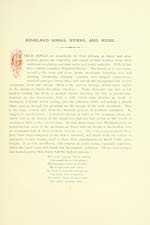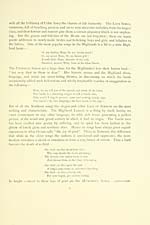Download files
Complete book:
Individual page:
Thumbnail gallery: Grid view | List view

From a literary point of view the crowning glory of Gaelic verse is the extraordinary
diversity and complexity of the Metres adopted. Abundant use is made of the
ordinary measures familiar in English poetry — the iambus and the trochee — but
recourse is also had to the difficult anapaest and the high-strung dactyl, and all four
are woven into numberless combinations, such as would delight the soul of an English
poet, but of which English itself is unfortunately incapable on account of its limited
selection of dissyllabic and trisyllabic rhymes. A common device of the Gaelic bards
was to make the latter half of each stanza the first of the next stanza, as in No. 12, Part
II., of this collection. Of course, that arrangement required the same rhyme to be
maintained throughout the whole song, but such is the wealth of Gaelic assonance that
this was accomplished with ease. Indeed it is no unusual thing for eleven out of twelve
lines to rhyme, and sometimes one rhyme is carried through twenty verses. The
most common form of verse in all Gaelic poetry — Scottish and Irish, ancient and
modern — is one in which the close of one line rhymes with an accented syllable
in the middle of the following line. This leonine rhyme may be exemplified
by the opening verse of the ancient poem known as " The Aged Bard's Wish " —
Oh, lay me by the burnie's side.
Where gently glide the limpid streams,
Let branches bend above my head.
And round me shed, O Sun ! thy beams.
But in many songs every line bristles with rhymed words, often words of more than
one syllable, as in the song No. 16 or hymn No 4. This free use of intricate rhymes
combined with the headlong sweep of rhythm found in the best songs can only be
imperfectly reproduced in English, but an imitation of one of Macdonald's stanzas
may illustrate some points of the literary structure of Gaelic verse —
Clan Ranald, ever glorious, victorious nobility,
A people proud and fearless, of peerless ability,
Fresh honours ever gaining, disdaining servility,
Attacks can never move them but prove their stability.
High of spirit, they inherit merit, capability,
Skill, discreetness, strength and featness, fleetness and agility ;
Shields to batter, swords to shatter, scatter with facility
Whoever braves their ire and their fiery hostility.
Neither is the aid of apt alliteration neglected in the adornment of these songs, which
indeed possess, in an unusual degree, all the attractions of form and colour found in
the best lyrical poetry. But, after all, the success of Highland songs lies in the
Expressiveness with which they interpret the feelings of the singers — the passions of
love and patriotism, the pathos of grief and the thrill of joy. They delineate with
sympathetic art the changing moods of the mountain landscape, and they pcirtrny
diversity and complexity of the Metres adopted. Abundant use is made of the
ordinary measures familiar in English poetry — the iambus and the trochee — but
recourse is also had to the difficult anapaest and the high-strung dactyl, and all four
are woven into numberless combinations, such as would delight the soul of an English
poet, but of which English itself is unfortunately incapable on account of its limited
selection of dissyllabic and trisyllabic rhymes. A common device of the Gaelic bards
was to make the latter half of each stanza the first of the next stanza, as in No. 12, Part
II., of this collection. Of course, that arrangement required the same rhyme to be
maintained throughout the whole song, but such is the wealth of Gaelic assonance that
this was accomplished with ease. Indeed it is no unusual thing for eleven out of twelve
lines to rhyme, and sometimes one rhyme is carried through twenty verses. The
most common form of verse in all Gaelic poetry — Scottish and Irish, ancient and
modern — is one in which the close of one line rhymes with an accented syllable
in the middle of the following line. This leonine rhyme may be exemplified
by the opening verse of the ancient poem known as " The Aged Bard's Wish " —
Oh, lay me by the burnie's side.
Where gently glide the limpid streams,
Let branches bend above my head.
And round me shed, O Sun ! thy beams.
But in many songs every line bristles with rhymed words, often words of more than
one syllable, as in the song No. 16 or hymn No 4. This free use of intricate rhymes
combined with the headlong sweep of rhythm found in the best songs can only be
imperfectly reproduced in English, but an imitation of one of Macdonald's stanzas
may illustrate some points of the literary structure of Gaelic verse —
Clan Ranald, ever glorious, victorious nobility,
A people proud and fearless, of peerless ability,
Fresh honours ever gaining, disdaining servility,
Attacks can never move them but prove their stability.
High of spirit, they inherit merit, capability,
Skill, discreetness, strength and featness, fleetness and agility ;
Shields to batter, swords to shatter, scatter with facility
Whoever braves their ire and their fiery hostility.
Neither is the aid of apt alliteration neglected in the adornment of these songs, which
indeed possess, in an unusual degree, all the attractions of form and colour found in
the best lyrical poetry. But, after all, the success of Highland songs lies in the
Expressiveness with which they interpret the feelings of the singers — the passions of
love and patriotism, the pathos of grief and the thrill of joy. They delineate with
sympathetic art the changing moods of the mountain landscape, and they pcirtrny
Set display mode to: Large image | Transcription
Images and transcriptions on this page, including medium image downloads, may be used under the Creative Commons Attribution 4.0 International Licence unless otherwise stated. ![]()
| Early Gaelic Book Collections > Blair Collection > Songs and hymns of the Scottish Highlands > (12) |
|---|
| Permanent URL | https://digital.nls.uk/75799530 |
|---|
| Description | A selection of books from a collection of more than 500 titles, mostly on religious and literary topics. Also includes some material dealing with other Celtic languages and societies. Collection created towards the end of the 19th century by Lady Evelyn Stewart Murray. |
|---|
| Description | Selected items from five 'Special and Named Printed Collections'. Includes books in Gaelic and other Celtic languages, works about the Gaels, their languages, literature, culture and history. |
|---|

